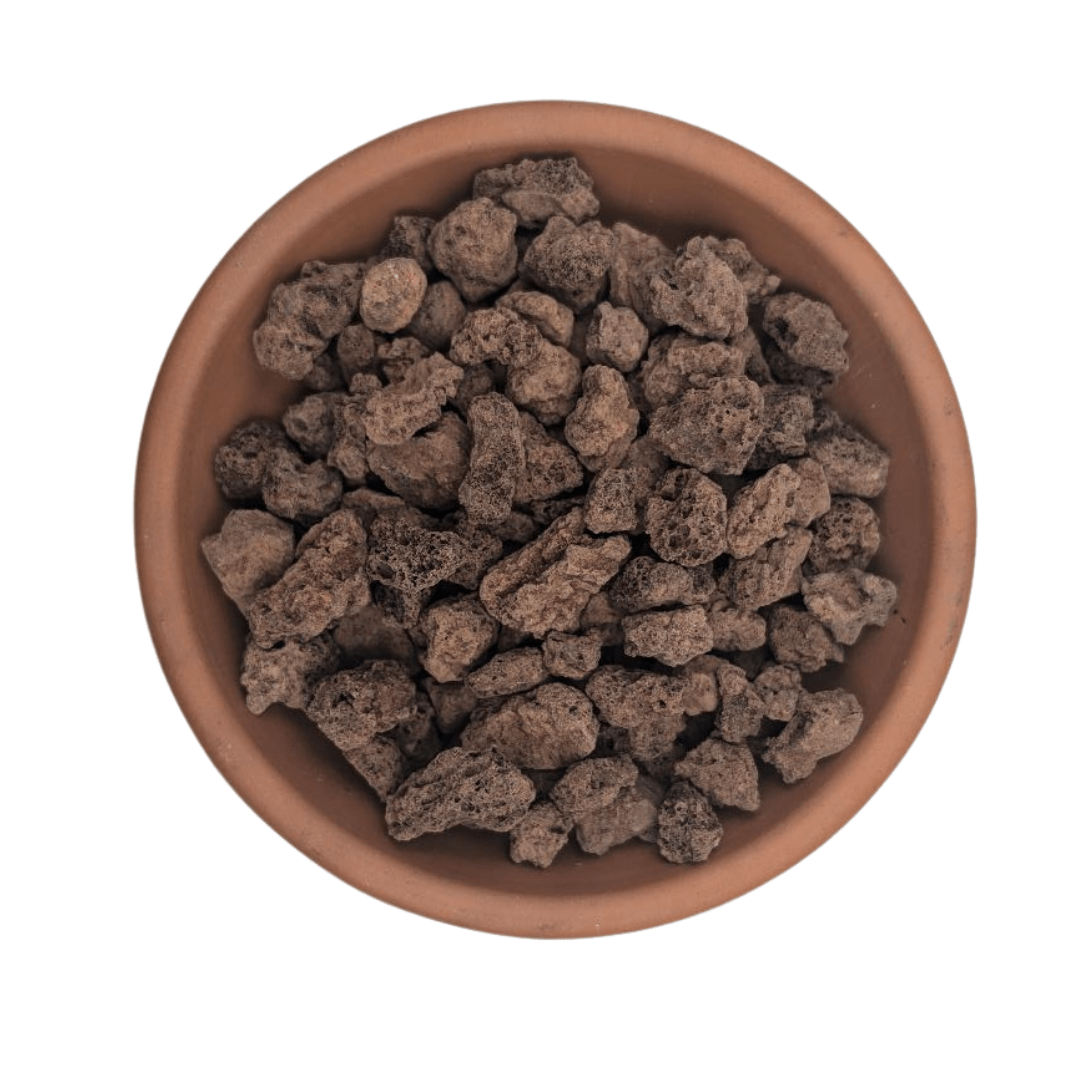Red Scoria 5-10mm is a naturally formed, highly porous volcanic rock ideal for gardeners and plant collectors looking to enhance soil structure and promote healthier root systems.
Sourced from rapidly cooled lava, this eco-friendly media improves aeration, drainage, and nutrient retention. Perfect for a variety of plants including cacti, succulents, bonsai, orchids, and more, it supports optimal growth in diverse horticultural applications.
Features
High porosity – Encourages superior root aeration, essential for healthy plant development.
Excellent drainage – Helps prevent waterlogging while retaining just the right amount of moisture.
Nutrient retention – Acts as a natural reservoir, slowly releasing nutrients to your plants.
Crush-resistant durability – Maintains its structure in no-till systems and under heavy use.
Multi-purpose use – Perfect for cacti, bonsai, succulents, orchids, and aroid mixes.
Natural earthy appearance – Adds a decorative touch while enhancing plant health.
Why You Should Buy
Red Scoria is a sustainable, long-lasting solution for gardeners seeking better soil structure and plant health. Unlike energy-intensive materials like perlite, Red Scoria is formed naturally and is eco-friendly. Its durability makes it a cost-effective option over time. Whether you’re growing an elegant bonsai or tending to rare aroids, this versatile media improves your soil’s performance with lasting results.
FAQs
What exactly is Red Scoria 5–10 mm?
A porous volcanic rock (a.k.a. lava rock) graded to 5–10 mm. It’s lightweight, super-aerated, drains fast, and won’t break down like bark or compost.
Why choose Red Scoria 5–10 mm for cactus, succulents and bonsai?
That size gives chunky airflow around roots, fast drainage, and enough texture for roots to grip. It’s the sweet spot for arid plants and bonsai containers.
How do I use Red Scoria in a potting mix?
Blend 10–30% by volume into your soil. Go ~30–50% for very drought-tolerant succulents/cacti, ~20–30% for bonsai and orchids, and ~10–20% to open up regular mixes.
Can I use Red Scoria straight, with no soil?
For some xeric species and bonsai training you can, but you’ll be watering and feeding more often. Most growers mix scoria with pumice/akadama/quality potting mix for a better moisture curve.
Is Red Scoria pH neutral?
Yep—effectively neutral for horticultural use, so it plays nice with most plants.
Will it hold any moisture or is it bone-dry like gravel?
It’s porous, so it holds a little water inside each piece while letting excess run off. Think “moist air” rather than “wet sponge.”
What’s the difference between red and black scoria?
Colour and quarry source. Horticulturally they behave the same—both are porous lava rock with great drainage.
How does scoria compare to pumice or perlite?
Scoria = durable, porous, heavier (won’t float), steady drainage.
Pumice = lighter, a touch more water-holding, pricier.
Perlite = very light, can float and crush; great for seed mixes but less durable long term.
How does scoria compare to akadama or zeolite?
Akadama adds structure and water-holding but breaks down over time. Zeolite has very high nutrient-holding (CEC). Scoria is the tough, airy skeleton—pair it with either for next-level mixes.
Should I rinse scoria before using?
Yes. A quick bucket rinse or hose blast removes red dust/fines so you don’t muddy the pot or clog drainage.
Does the red colour stain?
Only the loose fines. Once rinsed, it won’t keep leaching colour.
Can I reuse Red Scoria after a repot?
Absolutely. Knock off old roots, rinse well, and you’re good. For a deep clean, soak in 1:10 bleach for 10–15 min, then rinse thoroughly and dry.
Is Red Scoria safe for indoor plants?
Totally. It’s inert and odourless. Rinse first to minimise dust, especially if you’re potting indoors.
Is Red Scoria dusty—do I need PPE?
There can be quarry dust. Rinse outside. If you’re sifting larger volumes, a basic dust mask is sensible.
What’s the best mix for succulents and cacti?
A simple, proven blend: 1 part quality cactus mix + 1 part scoria + 1 part pumice/perlite. For ultra-arid species, bump the scoria/pumice.
What about bonsai?
Common bonsai blend: roughly equal parts akadama, pumice, and scoria. Adjust grain size to tree size—5–10 mm suits medium/large training pots.
Is Red Scoria good for orchids and aroids?
Yes. Use scoria as a chunky additive with orchid bark, or 10–30% in aroid mixes to stop compaction and improve airflow.
Can I use Red Scoria as a top-dress?
Yep. It looks clean, reduces algae/gnat issues on the surface, and keeps soil from splashing.
Will Red Scoria compact over time?
No. It’s rock—doesn’t collapse like bark or coco. That’s why it’s great in long-term containers and no-till setups.
Does Red Scoria add nutrients by itself?
Not meaningfully. It can hold onto nutrients you feed or mix in, but it’s not fertiliser. Pair it with your usual feeding program.
What fertilisers work well with scoria-heavy mixes?
Slow-release organics for base nutrition plus periodic liquid feeds. Because mixes drain fast, little-and-often feeding shines.
Is 5–10 mm OK for small pots?
For tiny pots/seedlings, step down to a smaller grain where possible. In a pinch, sift out the largest pieces for small containers.
How much do I need for a pot?
As a rough guide: a 150 mm pot holds ~2–3 L total. If you’re mixing at 30%, you’ll use ~0.6–0.9 L of scoria. A 5 L bag goes further than you think when used as an additive.
Does Red Scoria help with root rot?
Big time. It speeds drainage and pumps oxygen to roots—two things that starve rot pathogens of the conditions they love.
Is Red Scoria good for propagation?
For succulent leaf/cutting callus stages and woody cuttings, yes—either as a sterile bed or blended with pumice. It resists staying soggy.
Can I use Red Scoria in hydroponics or semi-hydro (ebb & flow, drip)?
You can. Rinse thoroughly first. It’s heavier than clay balls, so it won’t float during floods, and it offers great bio-film area.
Is Red Scoria aquarium-safe?
We don’t sell this as aquarium media. Some aquarists use lava rock, but colour fines can cloud water. If you try it, rinse obsessively and test in a bucket first.
Is Red Scoria suitable for terrariums?
Open terrariums/planters—sure. Closed, high-humidity terrariums—not ideal; it drains too fast and is visually chunky.
Will Red Scoria change my water pH or EC?
Not in a meaningful way for pot plants once rinsed. It’s effectively inert in the container environment.
Can I bake Red Scoria in the oven to sterilise?
We don’t recommend it—risk of moisture pops and a messy oven. Stick to bleach-soak or boiling water, then rinse.
Does Red Scoria help with fungus gnats?
As a top-dress it dries quickly and discourages larvae at the surface. Combine with good watering habits for best results.
Can I use Red Scoria with carnivorous plants?
Generally no. Carnivorous plants prefer very low-mineral media like pure sphagnum/peat and silica sand.
Outdoor use in rain and frost?
Absolutely. It’s weather-proof, doesn’t turn to mush, and keeps draining in wet winters.
Can I mix Red Scoria with coco, peat or compost?
Yes. Add 10–30% scoria to keep those fine materials from compacting and to boost airflow.
Does Red Scoria float?
No. Unlike perlite, scoria stays put during heavy watering or bottom-watering.
Is Red Scoria heavy?
Heavier than perlite, lighter than gravel. The extra weight helps stabilise tall plants and bonsai.
Any plant types Red Scoria especially suits?
Cacti, aloes, haworthias, euphorbias, agaves, bonsai conifers, olives, figs, orchids (as an additive), and aroids that hate soggy roots.
What if I only want Red Scoria for looks?
Go for it—use it as a clean, modern top-dress. It also reduces soil splash and helps you read surface dryness.
What’s in the bag—any fillers?
Just graded red scoria. Sieve and rinse at home to your preference and you’re set.
Quick start recipe for arid plants?
1 part premium cactus mix + 1 part scoria + 1 part pumice/perlite. Top-dress with scoria, water in, and start light, frequent feeds.
Any store-specific tips?
Rinse first, start at ~20–30% of your mix, and adjust based on how fast your pot dries. If you’re unsure, message us a photo of your plant/pot and we’ll steer you.


